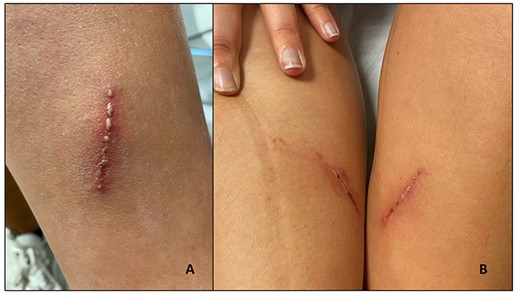-
PDF
- Split View
-
Views
-
Cite
Cite
Daniel Camprubí-Ferrer, Natalia Rodriguez-Valero, Magdalena Muelas, Alex Almuedo-Riera, Lucía Romero, Jose Muñoz, Blister beetle dermatitis with mirror lesions in a cluster of travellers from Kenya, Journal of Travel Medicine, Volume 28, Issue 6, August 2021, taab052, https://doi.org/10.1093/jtm/taab052
Close - Share Icon Share
A 20-year-old Spanish girl with no previous medical history presented with multiple itching and burning erythematous lesions in her limbs, which progressively evolved to pustulous linear lesions in a few days (Figure 1A). The onset of symptoms occurred 3 days before returning from a cooperation trip to Mfangano Island, in Victoria Lake, Kenya (from 20th January to 14th February 2020). Some of the skin lesions showed a mirror distribution (kissing lesions) and some appeared partially crusted (Figure 1B). Interestingly, 15 more young European cooperation travellers, whom the patient was living with, presented similar burning and itchy linear skin lesions in photoexposed areas; all of them denied any traumatism. The clinical suspicion of toxic ‘dermatitis linearis’ due to Paederus spp., was confirmed by the identification of many rove beetles in the household surroundings in Mfangano Island. The patient was treated with topical steroids, with a complete resolution of the lesions in 2 weeks.

Pustulous ‘linear dermatitis’ on the left arm (A) with mirror lesions on medial region of both legs (B) due to Paederus spp.
‘Dermatitis linearis’, also known as Paederus dermatitis, is a toxic dermatitis caused by the contact with pederin, a toxin mainly produced by rove beetles (Paederus) in people travelling to or living in tropical and subtropical regions.1 ‘Dermatitis linearis’ usually begins with linear erythematous lesions, which evolve to confluent vesicles and sterile pustules. Kissing lesions are common due to the contact of adjacent areas of skin.1 Differential diagnosis includes skin burns, zoster lesions, linear traumatisms and contact dermatitis, especially phytophotodermatitis.1,2 Due to exposition to the same ecological niche, cases usually appear in clusters.3 Treatment is based on antihistamines, washing the skin with soap and water and, occasionally, topical antibiotic-steroid combination. Complications and the use of systemic treatment are uncommon.1,2 Factors such as climate change and urban expansion to rural and agricultural areas may increase the interaction between Paederus beetles and humans, as it has seen through different outbreaks in travellers during 2020.2,3
Authors’ contributions
Daniel Camprubí-Ferrer and Natalia Rodriguez-Valero did a literature research and wrote the article. Daniel Camprubí-Ferrer took the pictures and prepared the figure. All authors attended the patient, discussed the case and reviewed the manuscript.
Funding
This work was not supported by any source of funding.
Conflicts of interest
The authors have declared no conflicts of interest.
References
Author notes
Both authors contributed equally to this work.



